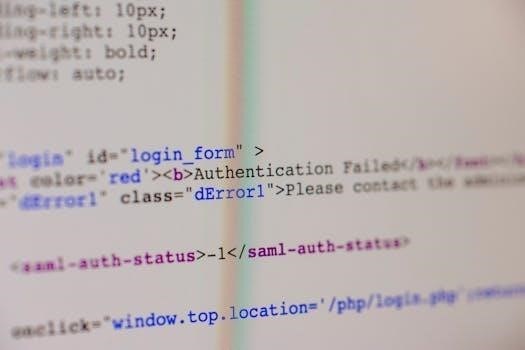
Fanuc CNC Programming Codes⁚ A Comprehensive Guide
This guide delves into Fanuc CNC programming codes, essential for machinists․ We explore G-codes, which dictate machine movements like rapid traverse (G00) and linear interpolation (G01), and also M-codes, which manage auxiliary functions․ Understanding these codes is crucial for effective CNC operation․ This will cover a comprehensive list of G-codes․
G-Codes Overview
G-codes, fundamental to CNC programming, are instructions that dictate the machine’s movements and actions․ These codes, often referred to as preparatory functions, tell the CNC machine how to move the cutting tool; They control aspects like rapid positioning, linear cutting, circular motion, and more․ Fanuc, a leading CNC controller manufacturer, employs a standardized set of G-codes, making them widely applicable across various machines․ The G-code language forms the core of instructions that the machine receives, which allows it to perform precise operations․ Whether it’s positioning the tool quickly to a new point or cutting along a defined path, G-codes are essential․ They are responsible for the geometric and motion commands the machine executes․ G-codes are the foundation upon which a skilled programmer can build complex machining programs, allowing for high levels of precision and automation․ Understanding them is critical for anyone working with CNC machines, so a comprehensive list of common and specific Fanuc G-codes is useful․ G-codes are used in machining centers and lathes․ These codes are the language a CNC machine understands․

G00⁚ Rapid Traverse
The G00 code, a fundamental G-code in Fanuc CNC programming, commands the machine to move its tool at the fastest possible rate, often referred to as rapid traverse․ This code is primarily used for non-cutting movements, such as positioning the tool to a starting point or moving it between operations․ Importantly, G00 does not follow a straight-line path, it moves to the designated point using the quickest route possible, not necessarily a linear one․ This characteristic makes G00 ideal for minimizing non-cutting time, thereby enhancing overall machining efficiency․ The speed of a G00 movement is determined by the machine’s parameters, ensuring that it operates within safe limits․ While G00 is fast, it’s not intended for cutting operations as it doesn’t control feed rates․ It’s a crucial function for reducing cycle times and improving machine productivity․ When using G00, it is critical to ensure that the tool path is clear of any obstructions because this movement is quick and doesn’t consider the geometry of the workpiece; The code is used to quickly move the tool to the programmed coordinates, increasing throughput of the machining process․
G01⁚ Linear Interpolation
G01, another cornerstone G-code in Fanuc CNC programming, instructs the machine to perform linear interpolation, meaning it moves the tool in a straight line from one point to another at a specified feed rate․ Unlike G00, which prioritizes speed, G01 is used for cutting operations where precise control over both the path and the speed is crucial․ When programming G01, you must define the endpoint coordinates (X, Y, and Z) and the feed rate (F) which dictates the speed of the movement․ This code is essential for a wide array of machining tasks, including straight cuts, milling of flat surfaces, and drilling operations․ The specified feed rate ensures that the cutting tool removes material at a consistent and appropriate speed, which is vital for achieving desired surface finish and accuracy․ G01 movements are always linear, allowing for predictable and controlled material removal․ When working with G01, it is important to select appropriate feeds and speeds based on the workpiece material, tooling, and desired cut depth, to ensure optimal machining results․ This code is fundamental for precision machining․
G02⁚ Circular Interpolation Clockwise
G02 is a crucial G-code within Fanuc CNC programming, specifically used to command the machine to perform circular interpolation in a clockwise direction․ This command enables the tool to move along a circular arc, making it indispensable for machining rounded features, such as arcs, fillets, and circles․ When using G02, it’s essential to define not only the endpoint of the arc but also the center point of the circle, which can be specified using I, J, and K parameters relative to the starting point․ The feed rate, denoted by F, is also crucial for controlling the speed of the tool along the arc․ G02 facilitates the creation of complex curved shapes with precision․ It is important to note that the direction of rotation is clockwise when viewed along the axis of motion․ Proper use of G02 in Fanuc programming significantly enhances the ability to create intricate parts, making it a core component in many machining processes, and achieving smooth and accurate curved profiles․ It requires a thorough understanding of how the center point parameters relate to the start point․
G03⁚ Circular Interpolation Counterclockwise
G03, a fundamental G-code in Fanuc CNC programming, is used to execute circular interpolation in a counterclockwise direction․ This command directs the tool to follow a circular path, forming arcs and curves that are essential in many machining operations․ Similar to G02, G03 requires specification of the endpoint of the arc, as well as the center point, typically through I, J, and K parameters that define the center relative to the arc’s starting point․ The feed rate, controlled by the F parameter, ensures smooth and controlled movement along the arc․ G03 enables the creation of various features, like intricate curves and rounded profiles, with high precision․ The counterclockwise direction is crucial for correctly machining parts when the required profile dictates it․ G03 is vital for producing complex geometries with precision and accuracy․ A thorough understanding of how the center point parameters relate to the start point is critical for successful implementation․ It is a complementary code to G02, and using them correctly allows for a wide range of curved shapes․ Improper use of this code will lead to incorrect part geometry․
M-Codes Overview
M-codes, often referred to as miscellaneous codes, are another crucial part of Fanuc CNC programming, playing a vital role in controlling auxiliary machine functions․ Unlike G-codes that govern tool movement, M-codes handle a variety of operations, such as spindle control (M03 for spindle start clockwise, M04 for spindle start counterclockwise, and M05 for spindle stop), coolant activation (M08 for coolant on, M09 for coolant off), and tool changes (M06)․ They provide the necessary instructions for the machine to execute actions beyond basic movements, enabling the complex automation of machining processes․ M-codes are essential for the overall operation of the CNC machine, facilitating the efficient running of programs․ It’s important to note that the specific functions of M-codes can vary slightly depending on the machine manufacturer, so it’s always best to refer to the machine’s manual for precise details․ Understanding M-codes is critical for achieving full control over a CNC machine, allowing for efficient and streamlined machining workflows․ They are a critical component to a complete CNC program․
Difference Between G-Codes and M-Codes
G-codes and M-codes are both fundamental to Fanuc CNC programming, but they serve distinctly different purposes․ G-codes, short for preparatory codes, primarily govern the geometry or motion of the machine tool․ They dictate how the cutting tool moves, such as rapid traversing (G00), linear cutting (G01), and circular movements (G02, G03)․ In essence, G-codes define the path the tool takes in space․ M-codes, on the other hand, are miscellaneous codes that control auxiliary functions of the machine․ These functions include actions like starting and stopping the spindle (M03, M05), activating and deactivating coolant (M08, M09), and initiating tool changes (M06)․ In short, M-codes manage the machine’s non-geometric operations․ While G-codes focus on the ‘how’ of movement, M-codes handle the ‘what else’ – the supporting actions that make a machining process complete․ Both code types are essential for precise and efficient CNC machining․ G codes are more about the tool path, while M-codes are about machine functions․ Understanding the difference is critical for efficient programming․
Common Fanuc G-Code List for Machining Centers
For machining centers utilizing Fanuc controls, several G-codes are fundamental for effective programming․ G00 is used for rapid traverse, moving the tool quickly without cutting․ G01 is for linear interpolation, enabling straight-line cuts at a specified feed rate․ Circular interpolation, crucial for arcs and circles, is achieved with G02 (clockwise) and G03 (counterclockwise)․ G04 provides a dwell command, allowing a pause during the machining process․ G20/G21 are used for inch/metric input․ G28 returns the tool to the machine home position․ G40 cancels cutter compensation, while G41 and G42 activate cutter compensation for left and right sides, respectively․ G43 activates tool length compensation․ G54 through G59 selects different work coordinate systems․ G90 specifies absolute programming, whereas G91 uses incremental programming․ G81 is a basic drilling cycle, while G83 and G84 are used for peck drilling and tapping cycles respectively․ This list is not exhaustive but covers the most common G-codes used for milling and machining operations․ Understanding these codes enables precise and efficient CNC programming․ These are the most common G-codes for machining centers․
Fanuc G-Code Compatibility
Fanuc G-code compatibility is a crucial aspect of CNC machining, as it determines how programs written for one machine might function on another․ Generally, Fanuc is considered a standard in the industry, meaning many machines from various manufacturers use controls that are either directly Fanuc or are Fanuc-compatible․ This compatibility allows for a degree of interchangeability of programs, but it is not always seamless․ While basic G-codes like G00, G01, G02, and G03 are universally recognized, some machine-specific G-codes may vary․ It’s essential to consult the specific machine’s manual to ensure proper program execution․ Additionally, machine tool builders might introduce their own variations or extensions of the standard Fanuc G-code set․ Therefore, it is important to check the compatibility of G-codes when using programs on different machines․ Furthermore, post-processors are often used to adapt G-code for different machines, ensuring compatibility․ Some controls may have specific G-codes for certain features, therefore a detailed understanding of the specific machine’s control is essential for effective CNC programming․

G-Codes for Lathes
G-codes for lathes, while sharing many similarities with those used in machining centers, have specific applications tailored to turning operations․ Lathes, which primarily deal with rotational machining, require different movements and controls than milling machines․ Common G-codes such as G00 for rapid traverse and G01 for linear interpolation are used in lathes, but their application involves movements along the Z-axis (longitudinal) and X-axis (radial)․ G02 and G03, for clockwise and counterclockwise circular interpolation respectively, are essential for creating arcs and radii on turned parts․ Additionally, specific lathe G-codes are used for operations like threading (G76), grooving (G75), and facing․ These codes often involve parameters for depth of cut, feed rate, and spindle speed which are crucial for achieving the correct surface finish and dimensional accuracy in turning․ Understanding the specific G-codes for lathe operations is vital for efficient and accurate CNC lathe programming and operation․ Furthermore, proper use of these codes ensures that the cutting tools move along the correct paths and speeds․ Also, it enables the user to produce the desired part geometry․
Coordinate System G-Codes (G54-G59)
Coordinate system G-codes, specifically G54 through G59, are essential for establishing multiple work coordinate systems on a CNC machine․ These codes allow programmers to define different origins for the same part or for different parts within the machine’s work envelope․ G54 typically represents the first work coordinate system, and each subsequent code (G55, G56, G57, G58, and G59) defines another․ This is particularly useful when machining multiple parts in one setup or when a single part requires machining operations from different reference points․ By using these codes, the programmer can switch between different coordinate systems without having to redefine the entire part program․ This significantly simplifies complex machining tasks and reduces programming time․ The work coordinate offsets are usually set up in the machine’s offset page, where the user specifies the X, Y, and Z offsets for each coordinate system relative to the machine’s home position․ The use of these G-codes enhances the flexibility and efficiency of CNC machining operations․ Furthermore, it allows for precise control over machine movements relative to various reference points․ Understanding these codes is crucial for operating a CNC machine effectively․
Understanding CNC Programming with G-Codes
CNC programming using G-codes is fundamental to operating Computer Numerical Control machines․ G-codes are a set of instructions that dictate the machine’s movements and actions․ They provide a language for programmers to communicate with the CNC machine, specifying how the tool should move, at what speed, and in what direction․ These codes are essential for machining parts accurately and efficiently․ Understanding G-codes is the first step towards writing effective CNC programs․ These codes control the geometry of the cutting path, hence the name “G-codes․” For example, G00 commands rapid traverse, while G01 initiates linear interpolation at a specific feed rate․ Circular motions are achieved with G02 (clockwise) and G03 (counter-clockwise)․ Mastery of these codes allows users to create intricate and complex parts․ Furthermore, CNC programming involves combining G-codes with other instructions, such as M-codes, which control auxiliary functions, and coordinate data that specify the tool’s location․ This combination enables the creation of precise machining processes․ Therefore, a solid understanding of G-codes is essential for every CNC machinist or programmer․ The knowledge of these codes is what makes CNC machining a highly automated process․

